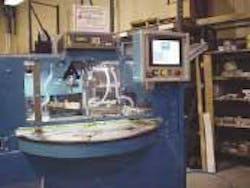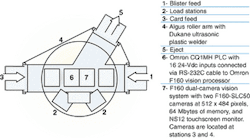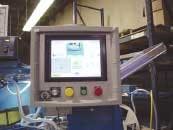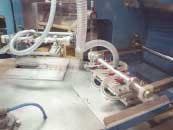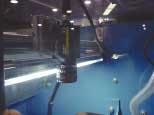Sensor system steers package inspection
Automated workcell integrates sensors, encoders, vacuum arms, and a smart dual-camera-head vision system to operate a plastic weld system.
By R. Winn Hardin, Contributing Editor
Manufacturers of small packaging operate similarly to high-technology semiconductor companies in one important way: they still use manual inspection for small-part production runs. Production engineers in both fields point to the same two reasons: capital cost versus a relatively small production run and the higher product-cost changeovers that occur in small-production-run plants. For example, control engineer Mike Kuhlow at Algus Packaging Inc. (DeKalb, IL, USA) says, "Vision inspection is built around doing a few things constantly, but our customers may run just a few hundred products. If they want to double-check an item, such as a card insert or a blister package, there are several advantages to using vision. But when customers offer a wide product variety that may require tooling changes, we need to keep the inspection solution as simple and reliable as possible."
Despite the capital constraints and unique needs of short-run packaging houses, decreasing vision-system costs and increasing ease of use are expanding the appeal of automated vision inspection systems for installation in production lines at small manufacturers. The key is cost-effective, integrated platforms that combine multiple packaging and inspection steps in a small footprint, at low cost, and with low maintenance, repair, and operation costs.
Based on field experience, small manufacturers have found that the selection and the integration of inspection-system sensors are the most important processes to cost-effectively automate their manual processes. Recently, Algus Packaging improved its 4S+2 rotary sealing machine to build a plastic packaging workcell. This workcell comprises multiple photoelectric, inductive, and vacuum pressure sensors; feed and supply photoelectric sensors; and an encoder to control a rotary-dial table and various vacuum pick-and-place arms, including one that controls a Dukane Corp. (St. Charles, IL, USA) 410 press and 3150 DPC II (dynamic process controller) ultrasonic plastic weld system. Developed for a small candy-packaging operation, it also includes an Omron Electronics (Schaumburg, IL, USA) F160 smart dual-camera-head vision system and an Omron CQM 1H programmable logic controller (PLC; see Fig. 1). The "clamshell-shaped" candy packages are fabricated with a single sheet of thermoformed plastic that is folded in the middle; the top half of the package is folded over and connected to the bottom section, thus, mimicking a clamshell.
System operation
The vision-based candy-packaging application needed to accommodate the different sizes of clamshell packages, as well as a wide variety of fillers, such as pieces of candy, automobile parts, or small electronic parts. In the Algus application, clamshell plastic packages are fed to a 5-ft-diameter dial table. They are then manually filled, inspected, ultrasonically welded, weld inspected, and then ejected to a conveyor if they pass inspection or indexed back to the operator if they fail (see Fig. 2).
The inspection process starts with movements of the mechanical arm, vacuum cups, and end-of-arm tooling that pick up an empty clamshell package from a feeder chute. An (optional) Omron E3S general-purpose photoelectric sensor monitors the clamshell packages and sends a 24-Vdc alarm to indicate a failure, when necessary, to the Omron PLC.
Algus' Kuhlow says he selected this PLC because it has no backplane, and I/O modules can be easily added as needed. The F160 vision processor can accommodate up to two support boards, one of which is a serial-communications unit with an RS-232C interface for the dual-camera system. The PLC also uses the Omron host-link protocol, which guarantees compatibility with the F160 vision system. It comes with multiple dc inputs (16 in the base model) for actuator and vacuum valve control, an optional NS12 touch-screen monitor interface that displays inspection images in real time, and visible operator alarms. Moreover, Algus and Omron have a long-standing relationship developing industrial platforms, Kuhlow adds (see Fig. 3).
To pick up the empty plastic-clamshell package, the PLC sends a 24-Vdc control signal to a four-way solenoid valve in the loading arm that engages a vacuum valve and lifts the clamshell package from the feeder chute to the dial table. Later in the packaging process, the PLC sends similar 24-Vdc control signals to the folding/closing station, as well as to Algus mechanical actuators at the weld and ejector stations. Furthermore, it transmits camera trigger signals to the two Omron F160 smart cameras. Timing for these various control signals are synchronized by the PLC using position data from an Omron E6CP 8-bit encoder. This encoder provides a unique binary output for every angle position of the input shaft on the mechanical indexer that turns the dial table.
Sweetened vision
During system operation, the first vacuum arm sets the empty clamshell package in the first of six metal nests on the dial (see Fig. 4). The nest with the empty plastic package indexes to the first of two positions, where the package is filled with candy. The dial indexes again, and the first of the two F160's SLC50 cameras takes a picture of the container to verify that candy has been put into the container.
According to Kuhlow, for this application the Omron F160 takes a black-and-white picture and converts the gray-scale image into a binary format of black-and-white pixels. Algus uses the F160 to count white versus black pixels within its 50-mm field of view after training the system on an empty plastic package. When more black pixels are present than pixels for the empty reference container, the package is judged to be full of candy and is passed on to the next dial station (see Fig. 5).
After the candy is inspected and accepted, a second vacuum arm places a cardboard label inside the package. The cardboard labels are fed from a separate feeder chute and monitored by a second (optional) Omron photoelectric sensor connected to the PLC via a 24-Vdc channel. As with the clamshell-package feeder arm, low-supply alarms are sent from the photoelectric sensor to the PLC and displayed for the operator on the NS12 touch screen.
Next, the dial indexes again and the PLC engages the vacuum actuators underneath the filled clamshell package, which pull the bottom half of the clamshell downward. Then, the lid lifts slightly, and a mechanical roller closes the clamshell package and applies 10 lbs of pressure to temporarily seal the clamshell package. As with the two feeder arms for the plastic packages and labels, the PLC controls the vacuum actuators under the nest with a small three-way solenoid valve. Algus uses a variety of vacuum pumps and generators. "We use industry-standard components, with an emphasis on price and reliability, to keep equipment costs low, downtime to a minimum, and repair/maintenance simple," Kuhlow says.
A (optional) Keyence Corp. of America (Woodcliff Lake, NJ, USA) AP-31KP vacuum pressure sensor with a digital display monitors the vacuum line for sudden disruptions in pressure. When the vacuum level rises above limits, which are set via the digital display, the pressure sensor sends a 24-Vdc alarm signal to the PLC. This signal is then displayed on the NS12 touchscreen monitor and informs the operator that either the vacuum arm failed to pick up a plastic package or a cardboard label, or the vacuum system is malfunctioning.
Welding options
The dial indexes again, taking the clamshell package to the Dukane ultrasonic welder and bringing the titanium horn down on the top of the edge of the plastic package. At the same time, an anvil comes up through the bottom of the dial, sandwiching the plastic lip between the horn and the anvil. Vibrating at up to 40 kHz, the Dukane welder seals the clamshell package for shipping. When sealing is taking place, an (optional) Omron E2E2 inductive proximity sensor detects the position of the lower anvil press and allows short-stroke operation. This sensor prevents the cylinder supporting the anvil from fully retracting every cycle, thereby reducing air consumption and increasing cycle time, Kuhlow adds.
After the clamshell package is welded, the dial indexes again, and the second F160-SLC50 camera takes another 512 × 484-pixel image of the weld region. This image is thresholded to a binary image, and the dark pixels are counted along the weld seam to check for a strong weld. If the weld inspection is accepted, a mechanical ejector arm lifts the package off the dial and onto a conveyor for final packing. If the automated inspection fails, the F160 vision processor sends a message across the RS-232C cable to the PLC, using the host-link protocol, and instructs the PLC to interrupt the ejector-arm vacuum solenoid. The PLC then indexes the dial again, which stops the first vacuum arm from picking up the next clamshell package and notifies the operator that a package requires attention.
According to Kuhlow, Algus plans to offer optional enhancements to the plastic packaging system. "At some point, if price allows, we'd like to do more work with the operator interface. We can use the NS12 touchscreen to set up and control the vision system beyond just monitoring the images. It comes with a built-in basic keypad controller so that you can adjust the vision system on-the-fly," Kuhlow says. Other enhancements would include making the up-to-16 stored images in the F160 system available either through the NS12 or remotely through an Ethernet or other network connection. ..
features, advantanges, benefits
Mike Kuhlow, control engineer at Aldus Packaging Inc. (DeKalb, IL, USA), says, "We were looking to build a plastic packaging system that would meet the needs of both small packaging houses and large customers that want to append a packaging workcell to an existing manufacturing line. With the addition of a packaging step that comes in a small footprint, large customers can package products immediately without the extra cost of trucking the products across the plant or to another location. By adopting this type of dual-packaging and inspection workcell, customers can immediately cut transportation costs, reduce inventory overhead by quickly packaging and shipping products, and, potentially, lower associated labor costs.
"We married an automated smart vision system to a rotary index table with extensive sensor feedback to create a clamshell packaging workcell capable of handling any small product from electronic components to candy. Automated vision gives us the capability to speed up the process by efficiently locating and inspecting the package and the ability to check the quality of the fill product and the integrity of the seal. These benefits again decrease client costs by reducing the possibility of product damage during shipping and its associated replacement costs," he adds.
Company Info
Algus Packaging Inc. www.algus.com
Dukane Corp. www.dukane.com/us
Keyence Corp. of America www.keyence.com
Omron Electronics LLC www.omron.com/oei
